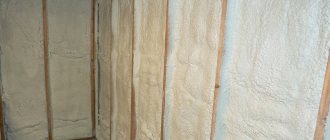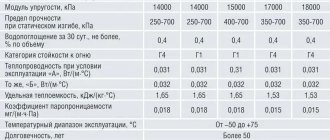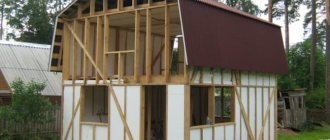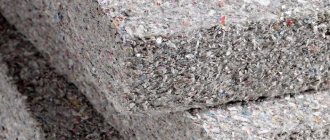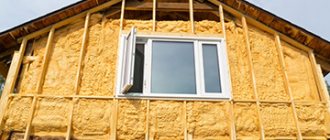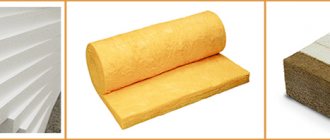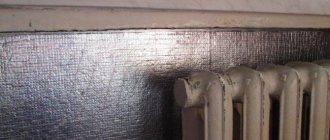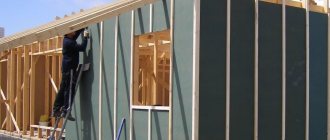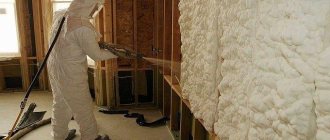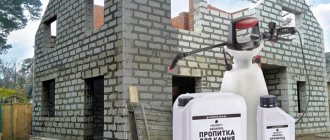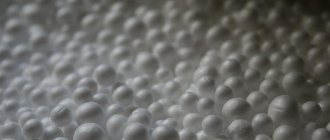Application of new developments
Competition in the construction market forces manufacturers to look for ways to improve product quality. To achieve this, work is being done in the following directions:
- creation of acoustic drywall;
- use of special filler with noise-absorbing properties for partitions;
- elastic pads under the frame, reducing the sound of impacts;
- filling partitions and creating false walls;
- spraying cellulose fibers inside partitions.
Acoustic drywall
and Aku-Line have mastered the production of acoustic plasterboard, which reduces the noise level when finishing interior partitions and when covering walls. Increased sound insulation of the partition is achieved due to a large number of holes, creating a reflection of a passing sound wave directed at the wall surface. In addition, a non-woven fabric is glued to the cardboard on the reverse side, which absorbs sound.
Acoustic plasterboard "Knauf"
Sound-absorbing filler inside partitions
Sound insulation of plasterboard partitions also requires the presence of a sound-absorbing filler between them. The same companies are developing it. Expanded polystyrene is widely used - a foamed thermoplastic made from fused granules with air cavities. The material also successfully copes with the function of thermal insulation. The addition of a fire retardant can increase the fire resistance of polystyrene foam. Judging by customer reviews, domestic polystyrene foam is a very poor thermal insulator.
Mineral wool slabs have high protective properties against sound propagation. produces a wide range of acoustic stone wool slabs, among which 4 cm thick products are often used for soundproofing walls. For effective dispersion of sound waves, the homogeneity of the slabs, which acoustic mats have, is of great importance.
Acoustic mats "Rockwool"
Partition materials with improved soundproofing properties are more expensive than usual, but with their help they achieve complete sound insulation. In addition, you can use filler of a smaller thickness, which will reduce costs and loss of room volume.
Membranes made of thin fabric with a fleecy coating are a high-quality sound absorber. The layer can be from 2.5 to 12 mm thick.
Polyester or polyurethane foam panels are used for internal filling and to create false walls. Some of them may be a fire hazard due to the content of flammable substances.
The cheapest filler for plasterboard walls is polystyrene foam. It reduces noise to some extent, but its efficiency is low.
Spraying sound-absorbing coatings
Spraying cellulose fibers with an adhesive composition is often used due to its low cost and the possibility of mechanizing the process. The method is used to correct acoustics indoors for entertainment and public purposes.
How does cellulose spraying occur?
Ready-made Sonaspray coatings have a texture like fur coat plaster. It can be coarse or uniform, depending on the size of the cellulose flakes. Since the coatings look impressive, dyes of a wide variety of shades are added to the solution. The coating can be painted after it has been applied.
The ability to spray a foamed cellulose solution on the surface of walls and ceilings made of building materials eliminates the need to create a frame that is used to hold gypsum board cladding. The manufacturability and cost-effectiveness of the process allows the team of specialists to ensure a productivity of 300 m² per day.
If you have the necessary equipment, the sound insulation of a plasterboard interior partition can be improved by applying cellulose from the inside.
Types of material
Today on the market you can find a huge number of insulating products that differ in their quality characteristics.
Insulation materials include the following materials:
- Styrofoam;
- expanded polystyrene;
- mineral wool;
- reflector (isolon);
- coconut and cork plates.
Each of them has a specific structure and parameters.
To choose the right insulation, you must initially know the characteristics of each of them.
Features of polystyrene foam and polystyrene foam insulation
These products have been used in finishing work for quite some time. They have earned recognition due to their optimal cost and excellent quality characteristics.
- Light weight, which avoids additional loads on the metal profile frame.
- Moisture resistance - products do not absorb moisture, and under its influence they are not able to deform.
- High thermal resistance - heated air masses will not be able to pass through their structure.
- Safety – the materials can be used without additional hand protection.
- Durability - the service life of polystyrene foam and polystyrene is the same and is more than 25 years.
- Practicality - the products are easy to cut and just as easy to install.
Polystyrene foam or polystyrene help make the process of insulating buildings faster and better. Despite the large number of advantages, the materials also have disadvantages. These include the following characteristics:
- Low strength during physical activity.
- Instability to fire - foam does not burn, but can melt.
- Toxicity - the manufacturing process of materials involves the use of synthetic raw materials.
In addition, polystyrene foam and expanded polystyrene act as vapor barriers. This negatively affects the insulation of rooms with high air humidity and high temperature conditions.
Mineral wool and its characteristics
There are several types of this material. These include the following products:
- glass wool;
- basalt wool;
- stone wool;
- slag wool.
Each of them has certain advantages and disadvantages.
The most popular insulation is glass wool. It is made from natural raw materials - sand, borax, soda and limestone.
The advantages include the following characteristics:
- Non-toxic - the material does not emit harmful substances.
- Good thermal conductivity.
- Resistant to aggressive environments.
- Fire resistance.
The material is also an excellent sound insulator.
Disadvantages include the fragility of the fibers in the structure, as well as low heat resistance. Glass wool loses its properties when exposed to temperatures of 450 degrees.
Today, this type of insulation is effectively used to insulate internal plasterboard walls.
Basalt wool is less popular due to cost. It is made from basalt raw materials. It has excellent heat and sound insulation properties. It is also heat-resistant and stands out among similar materials for its environmental friendliness.
Stone mineral wool is a relatively new type of insulation. It is made from volcanic rocks. Thanks to this, it has a dense structure. The material is not able to absorb moisture and perfectly absorbs noise. Its main advantage is environmental friendliness.
Slag waste is the raw material for the production of slag wool. This type of thermal insulation agent is less popular than all others. This is due to its technical indicators. It is capable of absorbing moisture, cannot withstand exposure to low and high temperatures, does not absorb sounds so well and is not environmentally friendly. The only advantage is low cost.
Reflector in insulation of structures
This product has appeared on the market recently, but has already gained recognition. It is made using foil and a rubber base. Thanks to this, the material reflects heat well and does not let it pass through the wall. It is also unable to absorb moisture.
The main qualitative characteristics of the reflector include the following:
- noise absorption;
- environmental friendliness;
- durability;
- resistance to low and high temperatures.
In addition, it is safe for human health. The rubberized base of the material increases its elasticity. This insulation for plasterboard partitions is also called isolon.
Coconut and cork plates
The products are made from coconut fiber and cork using special products. The materials are environmentally friendly and have good technical characteristics.
If you need to make high-quality heat and sound insulation of a structure, coconut and cork plates will be indispensable.
- high structure density;
- elasticity;
- moisture resistance;
- heat resistance;
- durability;
- practicality.
The structure quickly recovers after compression. The service life of cork insulation reaches 30 – 40 years. It is worth noting that the material does not rot or deform when exposed to alkalis, which cannot be said about coconut plates. They are able to absorb moisture during a certain cycle of exposure. A variety of bacteria form in the structure, with the help of which mold develops.
If coconut insulation is used, it is necessary to additionally make layers of hydro- and vapor barrier.
The cost of the material is quite high due to the use of natural raw materials in its production.
How to choose materials
Previously, before the invention of drywall, sound insulation was achieved by building a heavy brick or concrete wall. But it is obvious that this increases the load on the floor. Even earlier, partitions were made from so-called shingles. This is an interlacing of wooden slats, smeared with clay. This material is fragile and flammable, and the durability of the wall leaves much to be desired, fire safety even more so.
Fortunately, drywall is free from the following disadvantages:
- The material is non-flammable. If you choose a metal frame and mineral wool insulation, then you don’t have to worry about a fire in such a room. Plaster does not burn.
- The weight of one meter of brickwork is almost one and a half tons. A square meter of a single-layer gypsum partition weighs only 50 kg.
- A plasterboard partition is easy and quick to install. You just need to carefully mark everything and follow the instructions.
- The excellent sound insulation of the plasterboard surface in combination with other qualities makes the material the best option for building an interior wall.
The ceiling is both beautiful and protects from noise
Insulation for partitions
Is it possible to use polystyrene foam as insulation for partitions in a wooden house ? Yes, but with some degree of conditionality. Despite the inclusion of non-flammable components in its composition, the non-flammability of the material leaves much to be desired.
And in appearance, ordinary foam plastic and the one that passed the combustion test are no different. When purchasing, you will have to trust the documents accompanying the consignment of goods, or use it inside not wooden, but concrete structures, where the likelihood of fire is lower. GKL partitions have gained popularity due to their ease of installation and low costs for purchasing the necessary building materials. Drywall sheets themselves are considered a good insulation and sound absorber; the air gap between them enhances the effect. Sometimes insulation for gypsum board partitions is not inserted inside - it all depends on the requirements for the construction.
However, this approach is the exception rather than the rule. No one asks why insulate the external walls of the house, ceilings, floors, roofs, but you can hear conflicting opinions about insulation for partitions . Some say that it is not needed, because the heating system is single, and there is no point in isolating one heated room from another. There is a reason in such reasoning, but there are many who want to insulate, for example, a child’s room or bedroom, at the same time adding several additional sections to the radiator. It is more rational to insulate partitions with basalt or fiberglass sheet mineral wool with a density of 35 kg/m³ and a thickness of 50 mm - TECHNONICOL, ROCKWOOL, ISOVER, etc.
For example: TECHNONICOL Rocklight, TECHNONICOL Technolight Optima, TECHNONICOL Technolight extra, ROCKWOOL Superrock, ROCKWOOL Rockmin, ISOVER KL 37. For partitions, it is recommended to take a 50 x 50 mm profile 3 m long, along the perimeter - a 50 x 40 mm profile. Lay a layer of vapor barrier on both sides of the mineral wool insulation in the frame partition.
And yet, polystyrene foam is an excellent budget solution for sound and heat insulation of partitions. To increase fire safety (by the way, polystyrene foam does not burn, but melts), you can stick a façade mesh onto the foam sheets and coat the top with tile adhesive mortar. Polystyrene foam is a popular insulation material for partitions in a frame house (due to its low cost), but another problem awaits here: if mice get into the foam core, it will be difficult to get them out of there.
Penoplex insulation under drywall without frame
Step-by-step instructions will be like this:
- At the first stage, the base surface is prepared: the old coating is removed, cracks and potholes are sealed, and protrusions are knocked down. The wall should be as flat as possible.
- The surface is treated with a deep penetration primer.
- According to the manufacturer's recommendations, a special composition is prepared. If you don't have it, you can use tile adhesive.
- The inside of the insulation board is rolled with a needle roller. Another option is to brush it with a metal brush. This will ensure good adhesion to the adhesive solution.
- A fragment of insulation is applied to the wall and held for a minute. Be sure to check the correct installation at the building level.
- Begin gluing the penoplex from the bottom. It is recommended to move the rows relative to each other so that the slabs are staggered.
- The seams between the plates are filled with silicone sealant; wide cracks can be sealed with polyurethane foam.
- Drywall is attached to the insulation using glue. The scheme for applying the composition is the same as for penoplex slabs. It is recommended to place a layer of vapor barrier between them.
- After the glue has dried, which will take 24 hours, the drywall is finished. The seams are sealed using putty and serpyanka mesh, rubbed down, after which the entire surface is covered with a double layer of primer.
Technology for installing insulators under drywall
As a result of preliminary preparation of the walls, clean, dry surfaces should be formed, free from any unevenness in the form of holes, cracks and fungal infection. Pockets of mold are cleaned and treated with an antiseptic, and the defects are carefully puttied.
The blanks are fixed with flat cutters at the boundaries of the wall, then vertical slats are mounted in increments of 60 cm (the insulation must fit tightly into the resulting grooves).
The method of fixing the material depends on its essence. Foam boards are installed using special dowels and glue, the joints are additionally reinforced with construction tape, and the cracks in the area where they meet horizontal surfaces must be filled with silicone sealant. To fix the mineral wool, you will need foam glue: it is distributed around the perimeter of the slab and applied a little in the center.
The vapor barrier layer can be formed from dense polyethylene film or construction foil. Next, they begin covering the cake with plasterboard using self-tapping screws. The cracks are filled with putty, cleaned to prevent cracking of the putty, and the top is covered with paint or special tape. If the base was laid with a metal profile lathing, in order to prevent the occurrence of cold bridges, tapes from the main heat insulator must be placed in its cavity.
The service life of the solution considered is determined by the type of insulation used. On average, it varies between 20-30 years. As the material ages, it loses a third of its beneficial properties due to caking and drying out, so it should be promptly replaced with a new one.
It’s not just the heating system that plays a big role in creating a comfortable indoor environment. Insulation for gypsum plasterboard partitions is also important, as it maintains temperature conditions.
Installation of sound-absorbing panels
To assemble and cover the frame you will need the following tools:
- laser level;
- drill;
- screwdriver;
- construction stapler.
- metal profile;
- elastic polymer tape;
- plasterboard (from 12 mm);
- mineral wool slabs (thickness from 100 mm);
- polyethylene film;
- self-tapping screws;
- sealant.
The work is carried out in the following order:
The working principle of sound insulation.
- The walls are marked under a plasterboard frame using a level.
- The profile is placed along the perimeter of the wall surface (or between the walls if a false wall is being built), then guide profiles are attached to it in increments of 40-60 cm, fixing them with self-tapping screws every 60 cm.
- To increase the sound insulation of the walls, an elastic insulating tape is laid along the edges of the frame, which should fit tightly to the profile and base.
- If a new wall is built, the frame is covered with gypsum board on one side using special self-tapping screws.
- Mineral wool slabs intended for sound insulation are placed in the cells between the sheathing elements.
- The top of the mineral wool is overlapped with waterproofing, attaching the film with a stapler.
- The frame, filled with insulating material, is covered with plasterboard sheathing.
- The seams between the sheathing and the floor are filled with sealant.
Now you can fill the seams and finish the plasterboard walls.
The technology used makes it possible to reduce the noise level to small values, since the combination of the air gap (in front of the sheathing) and the loose structure of the mineral wool dampens sounds well.
Soundproofing the walls simultaneously serves as their insulation, which is especially in demand in corner apartments.
If a room requires enhanced sound insulation, it can be obtained by combining rigid and elastic materials. Such combined sound insulation can be created, for example, by combining cork and fiberglass materials.
Installation of insulation
Whatever type of thermal insulation agent is used, high-quality insulation is only possible if it is installed correctly. The material is secured in the cells of the metal profile frame. It is for this reason that the insulation is initially given the required dimensions.
After this, the sheets of thermal insulation are tightly inserted into the cells. In this process, the main thing is to eliminate the appearance of small gaps between the material and the metal profile. Heat will escape through them.
To secure elastic insulation to the surface, use special solutions or glue.
These types of materials include heat insulators made of balsa wood, coconut fiber and isolon. Their use in insulating a structure requires the presence of a rough surface for installation. It can be the back side of a sheet of drywall, a wall or a ceiling. If the insulation is mounted on GC, the surface of the sheets must be primed. This will increase the adhesion rate of the glue and the rough base. To increase the insulating properties of a structure, foam plastic is often used together with elastic insulation. This combination of materials has a positive effect on sound and vapor barrier performance.
Technology of thermal insulation of walls with plasterboard from the inside
The technology of insulating the walls of a room with plasterboard from the inside does not require special training of workers or expensive equipment. General construction skills and a universal tool are enough.
Tools and materials
During the work you will need:
- guides (metal profiles or wooden bars);
- gypsum boards;
- insulation in slabs or rolls;
- double sided tape;
- vapor barrier membrane;
- screws, dowels and other fasteners;
- anti-mold agents;
- putty;
- drill;
- screwdriver;
- hand tool.
The floor in the room must be cleared of debris and foreign objects.
Design
At this stage, the type of insulation, gypsum board and guides is selected.
If you are insulating a kitchen or bathroom, you should choose moisture-resistant plasterboard. For the boiler room, it is recommended to use fire-resistant.
Wooden guides are cheaper, but they are at risk of drying out and deforming in the event of temperature changes. The metal profile does not have such disadvantages. The number of guides is calculated based on a standard step of 60 cm.
When calculating the volume of materials purchased, a 5% reserve should be made in case of damage to gypsum boards and for cutting complex elements of walls and ceilings.
Stages of work execution
At the first stage, it is necessary to perform a number of preparatory work:
- clean the walls from dirt and mortar drips;
- dismantle all protruding objects: fasteners, remnants of fittings, sockets, lamps, etc.;
- fill all cracks and irregularities;
- treat with a composition against fungus and mold;
- dry the surface.
Next, marking work begins. Use a plumb line or a laser rangefinder and a chop cord
special attention should be paid to:
- parallelism of the marking of the mounting points of the guides;
- marking in corners and junctions of building structures: arches, window and door openings, columns, bay windows, ceiling beams.
After marking, they proceed to the installation of frame guides.
- The starting profile is glued to the floor using double-sided tape; the adhesive tape will improve sound insulation and protect against drafts;
- vertical profiles are attached to the starting strip with metal screws, and to the wall with screws on dowels.
The process of insulating walls with plasterboard
A very important stage is laying insulation into the guides. The quality of insulation will directly depend on the accuracy of the work:
- insulation sheets are placed in the guides from bottom to top;
- they should fit between the profiles without gaps, with some effort;
- the sheets are additionally attached to the wall with adhesive or disc-shaped dowels;
- All cracks and gaps must be tightly filled with scraps of material or sealed with foam.
Now it's time to install a vapor barrier:
- penofol is mounted with foil inside the room;
- The vapor barrier membrane is attached with the rough side inward; double-sided tape is used for installation.
And the final stage is the installation of drywall sheets. They are mounted horizontally, from bottom to top. Before screwing the sheet to the guides, you need to use markings and a level to make sure that it is positioned strictly horizontally. After the first layer is secured along all the guides, the next one is installed on top of it. Here you also need to ensure that the position is horizontal and that the gaps between the sheets are minimal.
As a rule, the size of the room does not allow installing only whole sheets of drywall. Pieces have to be mounted in corners and under the ceiling. Drywall should be cut on the floor, in a horizontal position, on a flat surface. It is enough to cut through the top layer of paper with a mounting knife. Now the cut piece can be broken off along the cut line.
Upon completion of installation, all joints between the sheets should be thoroughly puttied. After the composition has dried, it is leveled with fine sandpaper, achieving a completely flat surface of the wall or ceiling.
Now the surface of the insulated wall is ready for final finishing. Two main types are used:
- wallpaper;
- water-based paint.
When insulating rooms with high humidity with plasterboard, moisture-resistant types of plasterboard with special hydrophobic and antifungal impregnations are used. These panels are easy to distinguish: they are painted green. In wet rooms it is also necessary to arrange supply and exhaust ventilation to prevent air stagnation and mold formation.
How to install insulation under drywall: 3 options for Russian
Pay attention to the diagram shown at the top - here the insulation is installed outside, and the dew point (formation of condensation due to temperature changes) falls on the insulation layer. That is, the load-bearing wall is protected from the influence of temperature changes and air humidity, which helps to increase the service life of the building. The most important thing is that these panels fit tightly to the profiles.
That is, in essence, this is their fixation. If it is mineral wool, where the panel does not have rigidity, then in this case mushroom dowels are used, which press the material to the rough surface. In fact, the technology of insulating walls with plasterboard from the inside largely depends on the wall itself, that is, on its thickness and the presence of insulation with streets. However, the installation technique itself does not depend on these parameters and remains unchanged, so I want to fix the main direction precisely on the technical conditions. Mineral wool or polystyrene foam can be installed between the profiles, and it does not matter what they are made of - metal or wood.
Typically, foam panels are used for this, but mineral wool blocks can also be used. If the walls are insulated from the inside with mineral slab plus plasterboard or other cladding, the dew point moves. And it, as a rule, ends up between the insulation and the wall. After installing the insulation, you can sew up the partition with sheets of plasterboard and begin finishing work - puttying, painting or wallpapering.
Drywall sheets create an almost ideal surface, which is very important for subsequent finishing work. If possible, it is better to purchase insulation in the form of rolls. The slabs are not so easy to use.
In contrast, rolls have a standard width of 0.6 m. This is exactly the distance maintained between the metal frame posts.
What not to do
Often, when trying to limit themselves from noise, many people use materials that are not the most suitable for this. First of all, this applies to polyurethane foam.
Not only does it provide poor protection from noise, but it is also not fire safe. The foam melts perfectly and releases a suffocating gas. The same can be said about polystyrene foam.
By creating a simple partition made of gypsum sheets to protect against noise, and not filling it with a noise absorber, they thereby turn it into a large resonator, which only worsens the situation.
Insulation from sound penetrating through technological openings - sockets, air ducts and the like - is required. If nothing special is done with the air ducts and ventilation ducts, then the outlet can be treated from the inside even with a simple sealant, which, although slightly, will reduce the amount of incoming noise.
When using roll sound insulators and membranes, you must not leave joints or gaps between the parts of the coating. It is necessary to glue them overlapping.
Application of damping and reflective materials
Professionals have developed an ambivalent attitude towards all kinds of materials that act as an acoustic barrier. Some masters have learned to use them correctly and appropriately, others completely neglect them or, on the contrary, attribute too outstanding properties. To understand the function of separating layers, you need to make a short excursion into the physics of mechanical vibrations.
In general, noise propagation between two rooms separated by a sealed partition occurs for two reasons. On the one hand, the partition coating facing the sound source may reflect it poorly, that is, it absorbs most of the vibration energy, transmitting it further into the pie. On the other hand, sound insulation can be worsened by the fact that the partition itself is too dense, that is, when vibration is transmitted between the elements, it is not damped or dissipated. As many have already guessed, mineral wool also acts as an acoustic separator, but this is the main obstacle to the propagation of sound, while there may be additional ones:
- Corrugated multilayer cardboard. Its cellular structure contributes well to the damping of vibrations, while the material is quite dense and allows even alternation of layers of cladding and damper.
- Foam rubber and polyethylene foam. These materials are characterized by porosity and elasticity; they also help dampen airborne noise well, but they are usually used under the outer layer of drywall.
- All kinds of acoustic membranes, films and non-woven canvases. They are mainly used at the interface of dissimilar materials or to reduce the contact area. When installing partitions, it makes sense to lay non-woven canvases and membranes between the profile and the cladding.
- Dissipative plates with a characteristic serrated surface geometry. These materials prevent the dense barrier that absorbs the noise from spreading it from the opposite side. Such materials can be used in conjunction with low-density filler; they are glued to the wrong side of the skin in the spaces between the posts.
An example of using an acoustic membrane to soundproof a plasterboard wall.
In general, the operation scheme of acoustic layers is quite transparent. Due to their inclusion in the casing, an effect is achieved that the outer layer reflects noise well, transmitting a minimum of vibrations inside the partition, which can be effectively absorbed by the filler and the back side of the casing. To do this, you must follow the installation order and use the correct fastening scheme.
When is it necessary to insulate indoor walls?
The most effective option for wall insulation is installing thermal insulation on the outside of the façade. But only owners of private houses can afford this. This method is also expensive. In apartment buildings, if they are not insulated from the outside with thermal insulation materials, residents have only one choice for insulating the walls themselves - internal thermal insulation. Private homeowners also often choose this option as an economical one.
They prefer to use plasterboard for wall cladding because it has a number of advantages over other finishing materials:
- lightweight and easy to handle;
- has thermal insulation properties;
- allows you to quickly create perfectly smooth surfaces;
- under such a coating you can place any type of insulation, even soft ones;
- its cost is not high.
Recommendations for maximum effective sound insulation
All layers must have special soundproofing pads, since noise penetrates the room layer by layer. For greater efficiency, it is recommended to mount two separate frames, and then attach the sheathing to them. When choosing a soundproofing material, it is necessary to pay special attention to the sound absorption coefficient, which is calculated as the ratio between the soundproofing properties of materials and the noise level indoors or outdoors. To ensure quality, this indicator must be at least 0.8.
Remember that quality sound insulation is impossible without complete tightness of the structure. To prevent sound from penetrating, there should be no holes or cracks on the surface. If available, use silicone sealant. Polyurethane foam should not be used for this purpose, as it can easily ignite. To achieve a greater level of sound insulation, mineral wool can be placed between the partitions. Remember also that the thickness of the absorbent layer must be at least 50 mm or 70% of the thickness of the partition.
Features of thermal insulation with plasterboard
Advantages of gypsum board cladding in terms of wall insulation in an apartment:
- low conductivity of panels;
- installation is carried out only on flat surfaces, most often the sheets are installed on the sheathing - such a frame forms an air gap between the wall and the sheathing, which has a positive effect on retaining heat in the room;
- free space (cells in the sheathing) can be filled with materials with a high ability to retain thermal energy;
- In summer, such rooms will be cooler due to the fact that additional layers will not allow heat from outside.
Installation of insulation under plasterboard is carried out only on flat surfaces.
In apartment buildings, internal insulation is more accessible than external insulation; plasterboard is one of its most economical options. The panels are easy to process and undemanding in maintenance, they can be applied with any type of finishing, they form a perfectly flat surface without weighing down the load-bearing structures
GCRs are combined with most types of insulating (hard, soft) and finishing materials, which is important when creating interior design
Options for wall insulation using plasterboard
Drywall itself cannot be called an excellent heat insulator; it is capable of conducting heat 2.5-3 times better than mineral wool, and 5-8 times better than various brands of foam plastic. A more acceptable result can be obtained by installing sheets in several layers, but this method is technically complex and has low economic efficiency. Therefore, using plasterboard coatings are most often used for insulation
- Installation of gypsum boards without the use of additional heat-insulating materials. The main role is played by the air cushion between the sheathing and the main wall. This option has recently been used quite rarely.
- Installation of gypsum boards with filling of voids with mineral (fiberglass) wool. Allows you to obtain fairly effective heat and sound insulation. This method has one drawback: the insulating material (cotton wool) absorbs moisture quite well, losing its properties; in addition, for reliable insulation, a slightly larger layer of heat insulation is required.
- Installation of gypsum boards with insulation with simple or extruded polystyrene foam. Extruded foam plastic has a low vapor permeability coefficient, practically does not absorb water, and at the same time transmits a minimal amount of thermal energy.
- Installation of gypsum boards with filling of the internal space with polyurethane foam or penoizol. Allows you to achieve maximum filling of all voids, increases the thermal insulation qualities.
Stages of thermal insulation of a wall
In order for the work process to proceed quickly and properly, you should prepare the necessary tools. This will significantly speed up the work on protecting the walls with insulation.
The following materials will be required:
- plasterboard sheets;
- self-adhesive tape;
- insulation;
- membrane to ensure maximum vapor barrier;
- screws, nails;
- hammer, screwdriver, hacksaw;
- yardstick;
- metal profiles or wooden slats for constructing the frame;
- fastening materials.
For 1 sheet you need approximately 30 pieces of self-tapping screws. It is best to buy screws 20 mm long.
As for the manufacture of the frame, the profile must be taken of 2 types: marked CD and UD. The length is selected based on the size of the room.
Frame design
It consists of drawing the perimeter and thinking through how the frame will be positioned on the wall. A simple pencil and a building level are enough.
Preparation:
- surface cleaning;
- smooth out all the unevenness and fill up the cracks and depressions;
- drying with a heater or blow dryer;
- getting rid of mold and mildew.
Sometimes it is necessary to treat the walls with a special waterproofing putty to prevent the occurrence of dampness. First, the layer is applied vertically, then horizontally.
Frame construction
Installation of a frame from profiles for plasterboard You need to mount the frame according to pre-made marks. To avoid contact of the metal structure with the wall, a tape prepared in advance is glued to the base of the profile. The frame parts are fastened to the wall using self-tapping screws and dowels.
Before laying the insulator, the surface is prepared in advance. Weak areas of plaster are removed or restored. To eliminate the possibility of the formation of fungus and mold, it is necessary to treat with a primer and an antiseptic.
Sheets of plasterboard are installed on a frame made of metal or wood. A metal frame will last significantly longer than one made of timber.
In the area where batteries are located, where installing thermal insulation is difficult, penofol can be used.
You can make a frame from bars under drywall
Assembling the frame begins with the installation of guides created from the UD profile. The slats are mounted on the ceiling and floor with a distance of 50-60 mm from the walls. A section of the rack profile is inserted into the guides. The ends are fixed using small self-tapping screws (“fleas”). The edges of the hangers are folded from the sides and connected to the slats. The pitch between the profiles must be observed so that there are 3-4 slats per sheet.
To improve the rigidity of the structure, it is necessary to make transverse bridges from the CD profile. The profile is cut so that its length overlaps the adjacent slats by half. Use metal scissors to cut off the shelves. Then the blanks are fixed with fleas onto the frame.
Vapor barrier device
Penofol is often used as a vapor barrier. Before attaching it, you need to make sure that the side of the material with foil is facing inside the room.
As for the vapor barrier material, which has a rough surface, its uneven side should also be directed into the room.
Insulation
The insulation should be cut using a special knife. The insulation should be cut into pieces, the size of which should match the parameters of the frame cells.
If you use foam plastic as a thermal insulation material, then it should be attached with special glue prepared with the addition of water. Each piece should fit tightly to the surface. If gaps appear between the parts, they are filled with polyurethane foam. After the glue has dried, the foam is fixed with dowel umbrellas. Dowels should be placed in the corners of the sheet and one in the center.
After laying the internal thermal insulation, they begin to sheathe the frame with sheets of plasterboard.
When the screw is screwed in, its head should sink slightly, by 1-1.5 mm, but without tearing the cardboard. To make fixing easier, it is better to buy bits with a limiter.
After the walls are completely covered with plasterboard sheets, the surface is finished in any usual way. Insulated walls can also be covered with wallpaper or painted.
Frame installation and preparation for insulation
The frame for all these types of insulation is installed according to the same rules; the difference is manifested only in the distance between the wall and the sheathing, which is determined by the thickness of the required insulation (according to thermal engineering calculations). To install the frame you will need the following materials:
- Galvanized starting profile UD 28x27 mm.
- CD wall profile 60x27 mm.
- Direct hangers for attaching wall profiles.
- A tape made of foamed polyethylene or other similar material to eliminate cold bridges between the main wall and the plasterboard covering.
- Plastic quick installation (dowel-nails) 6x40 or 6x60 mm, metal should not be used, again in order to prevent the formation of cold bridges. Used for attaching UD profiles and direct hangers to the main wall.
- Self-tapping screws 9.5x3.5 (fleas, bedbugs, seeds) for fastening profiles to each other and with hangers. Metal screws, 25-35 mm long, for mounting gypsum board sheets.
In some cases, a wooden block is used to install the frame, but in this case, especially if its cross-section is insufficient, it may deform in the future, so this material requires more careful fastening. A metal profile frame can be assembled much faster.
First of all, it is necessary to treat the surface of the wall. It must be treated with a deep penetration primer with fungicidal additives. In most cases, this will help protect the surface from the appearance of fungus; in extreme cases, it will delay its formation for a long time. For this purpose, you can use primers from the companies Ceresit and Knauf; many domestic manufacturers also produce them.
We won’t dwell too much on the technology of installing the supporting frame; in principle, it has no differences from the finishing of internal walls, the same pitch of the wall profile (60 cm in the center), the same distance between the fasteners (60-100 cm), it is also necessary to maintain the level, You should pay attention only to the following points:
- It is necessary to lay a foamed PPE tape under the starting profile (similar to sound insulation).
- In addition, such a substrate should be used under each suspension; this will prevent the formation of a cold bridge between the main wall and the sheathing through the metal elements of the frame. When using wooden slats and bars, the use of such tape for fastening is not required.
- Another nuance that concerns the use of foam plastic as insulation. It is almost impossible to place it under an already mounted frame, so you should first insert cut strips of material into the wall profile, and the remaining voids can be filled with ordinary foam.
- In addition, the required thickness of the insulation should be taken into account, that is, the minimum distance from the main wall to the inner surface of the gypsum board (taking into account the level difference) should not be less. And in the case of using even slightly larger mineral and fiberglass wool, the resulting air gap will improve thermal insulation and protect the plasterboard from getting wet in the event of condensation forming and the main layer of insulation getting wet.
Advantages and disadvantages of plasterboard wall structures
To begin with, it probably makes sense to briefly highlight the positive and negative aspects of a wall frame structure made of plasterboard. Having understood them, it will be possible to competently decide whether such a partition is suitable for a particular case or not.
After finishing work, the plasterboard structure will look like a full wall.
So, the advantages of plasterboard partition structures include the following points:
The materials used for the construction of such walls are quite light, so they will not weigh down the interfloor floors. Consequently, the mounted structure will be absolutely safe for the building. Walls and partitions made of plasterboard are not permanent, so their construction does not require obtaining a permit, the obtaining of which involves the loss of a considerable amount of time, money, effort and nerves. Drywall is produced in several versions - these are simple sheets (GKL), moisture-resistant (GKLV), fire-resistant (GKLO). Lightweight sheets are produced for ceiling structures
Therefore, walls and partitions can be erected from this material in any of the rooms, including in the bathroom or near the stove or fireplace. The affordable cost of both the drywall itself and the components for building the frame allows a family to purchase them for repairs, even with a modest budget. It is quite possible to design and install plasterboard walls that have complex decorative and useful shapes, such as arched doorways or functional niches and cabinets, allowing you to avoid purchasing furniture accessories. When leveling walls with this material, you will not need to remove the old plaster. The construction of walls made of plasterboard (or when leveling walls with plasterboard using a frame method) allows for immediate insulation and sound insulation work. You can hide electrical wiring in the frame of the wall being built. There is a complete opportunity to do without the involvement of a team of builders, since all the work can be done independently or with one assistant. The material is “breathable” and environmentally friendly, which is important for furnishing residential premises. A wall or partition erected using this method turns out perfectly smooth, suitable for any facing material, be it wallpaper, paint or ceramic tiles.
Moisture-resistant plasterboard sheets are used to level or line the walls in the bathroom.
Drywall prices
drywall
Now, for the objectivity of the picture, it is necessary to consider the negative aspects of the plasterboard structure. It is advisable to know about them in advance, so that later, when using the rooms, you do not encounter some unexpected inconveniences. :
Wooden bookmarks in a metal frame of a plasterboard structure
- A wall made of this material will not be able to withstand hanging any heavy objects directly onto the plasterboard, since the sheets are quite thin (12.5 mm), fragile, and the gypsum itself is not particularly strong. Therefore, if in the future there is a plan to hang, for example, a TV or sconce on the wall, then their location must be determined at the design planning stage, and additional jumpers made of a metal profile with wooden bookmarks must be provided for fastening.
- The wall structure will have a minimum thickness of about 80 mm, and often much more. This reduces the area of the room somewhat. But think about it, what if you use other materials for the partition? Almost any other will give even greater thickness. Therefore, this drawback can be called very doubtful.
Soundproofing of plasterboard partitions
Properly selected material for soundproofing plasterboard partitions is the key to peace and quiet. By protecting against intrusive conversations, music or TV in the next room, it helps maintain nerves and healthy relationships.
A typical modern interior partition is made of a wooden or metal frame covered with plasterboard on both sides. Such a wall does not resist the passage of sound well. If a similar redevelopment has been made in the apartment, then only soundproofing of plasterboard partitions will save you from noise.
Best materials
The most effective material that completely guarantees results does not yet exist and is unlikely to ever be made. There is also no universal, one-size-fits-all guide to follow when making a room barrier.
The effectiveness of activities depends on each stage. The very first is the installation of the frame. Its design will simply ring if you do not take protective measures - insulate the floor and ceiling from it. Without using a damper tape, it is impossible to achieve any significant results. An excellent damper is the proven Vibrostek-M tape.
As for the frame, there is not much to think about what to choose from - either wood or a metal profile. Their indicators are approximately the same, and little depends on the choice in favor of one or the other.
The panels covering the frame play a significant role. Acoustic plasterboard produced by Knauf or similar products from the Aku-Line line manufactured by Giprok can significantly reduce penetrating noise.
A responsible approach to the task requires that the sheets be laid in 2 layers. Just one layer does not give a quality result. Acoustic triplex, a specialized three-layer material for sound insulation, can also be used as sound insulation under drywall.
A good triplex is produced under the SOUNDLINE-dB brand.
The main role is played by the layer of aggregate laid between the panels. Sound-absorbing boards SCHUMANET-ECO have good performance and suitability for domestic use in apartments.
If the partition has already been built, there is not much to choose from. But it is not necessary to disassemble it and rebuild it. Sound absorption can be significantly improved by using wall membranes. Thanks to them, the volume of reflected sounds directed at the surface of the walls is reduced.
The process of installing sound insulation in a plasterboard partition
A good result depends not only on the materials, but also on how correctly and responsibly the sound insulation is done. Here we can highlight the following, most significant stages:
- Soundproofing a plasterboard wall in an apartment begins with mounting its frame on vibrating tape. It is laid in two layers, attached to the walls, floor and to each other with vibration sealant;
- Frame installation. It is advisable not to place sockets and switches on the future wall - sounds are transmitted very well through them. A rational solution would be to make the distances between the profiles correspond to the size of the soundproofing slab;
- Installation of plasterboard sheets of partitions on one side. Acoustic plasterboard is installed with perforations facing outwards;
- Laying sound-absorbing slabs in the interior partition. Their thickness determines what the thickness of the interior partitions will be;
- The final stage is when the slabs are covered with gypsum boards. To do everything correctly here, the joints need to be sealed with vibration sealant.
Insulation for plasterboard partitions
Insulation for gypsum plasterboard partitions does not require special conditions or properties. Drywall has enormous advantages over other methods of interior finishing. It is easy to cut and install, and the thermal insulation is aesthetic and inexpensive.
- installation using a frame “eats up the space of the room;
- the material is very fragile, not suitable for hanging heavy objects;
- GCR does not differ in mechanical strength, it breaks easily upon impact;
- untreated sheets emit dust that is harmful to health.
Foamed polyethylene film covered with aluminum foil is ideal as a vapor barrier cushioning material that prevents the formation of condensation inside the partition. To learn how to insulate walls with plasterboard, watch this video: Self-adhesive tape is made of polystyrene components and has a thickness of 3-4 mm. It is glued to effectively absorb sound from the ceiling, walls, floor, and even from the profile frame itself.

